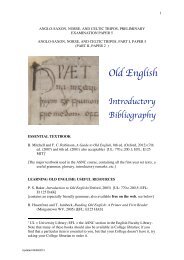Scandinavian history in the Viking age - Department of Anglo-Saxon ...
Scandinavian history in the Viking age - Department of Anglo-Saxon ...
Scandinavian history in the Viking age - Department of Anglo-Saxon ...
You also want an ePaper? Increase the reach of your titles
YUMPU automatically turns print PDFs into web optimized ePapers that Google loves.
<strong>Scand<strong>in</strong>avian</strong> History <strong>in</strong> <strong>the</strong> Vik<strong>in</strong>g Age<br />
[I198] G.F. Bigelow, ‘Issues and prospects <strong>in</strong> Shetland Norse archaeology’, (H8):9-32<br />
[I199] B.E. Crawford et al., The Bigg<strong>in</strong>gs, Papa Stour, Shetland: <strong>the</strong> <strong>history</strong> and excavation <strong>of</strong> a royal<br />
Norwegian farm, Society <strong>of</strong> Antiquaries <strong>of</strong> Scotland monograph 15 (1999) [UL T486.b.18.15]<br />
For place-names and settlement cf. (B875) and:<br />
[I205] L.J. Macgregor, ‘Norse settlement <strong>in</strong> Shetland: a case study’, (A60) vol. 6 (1987), 27-45 [UL<br />
L592.c.25.6]<br />
Ireland<br />
The pattern <strong>of</strong> Norse activity <strong>in</strong> Ireland is similar <strong>in</strong> outl<strong>in</strong>e, at least at first, to many colonies elsewhere.<br />
The first raids are documented from <strong>the</strong> end <strong>of</strong> <strong>the</strong> eighth century and persisted throughout <strong>the</strong> early<br />
n<strong>in</strong>th; <strong>the</strong>re appear to have been rival Norwegian and Danish fleets <strong>in</strong> operation dur<strong>in</strong>g this period, and<br />
many Vik<strong>in</strong>gs seem to have hired <strong>the</strong>mselves out to local rulers as mercenaries. The first period <strong>of</strong><br />
<strong>Scand<strong>in</strong>avian</strong> <strong>in</strong>volvement <strong>in</strong> Ireland can perhaps be said to have ended with <strong>the</strong> expulsion <strong>of</strong> many<br />
warlords around 902, seem<strong>in</strong>gly help<strong>in</strong>g to prompt a large-scale emigration to Iceland (G40 ff.). The<br />
tenth century is characterised by <strong>the</strong> shift<strong>in</strong>g k<strong>in</strong>gdoms <strong>of</strong> Dubl<strong>in</strong> and York under supposed descendants<br />
<strong>of</strong> Ivar <strong>the</strong> boneless (I30 ff.), but <strong>the</strong> <strong>in</strong>fluence <strong>of</strong> <strong>the</strong>ir rulers faded after <strong>the</strong> middle <strong>of</strong> <strong>the</strong> tenth century,<br />
culm<strong>in</strong>at<strong>in</strong>g <strong>in</strong> <strong>the</strong> battle <strong>of</strong> Clontarf <strong>in</strong> 1014. In <strong>the</strong> course <strong>of</strong> <strong>the</strong> eleventh century, most <strong>of</strong> <strong>the</strong> Vik<strong>in</strong>g<br />
towns or camps returned to Irish control, and <strong>the</strong> reign <strong>of</strong> <strong>the</strong> last major Vik<strong>in</strong>g ruler <strong>of</strong> Dubl<strong>in</strong>, Sigtrygg<br />
silkbeard (from 989 to 1042) signalled <strong>the</strong> serious assimilation <strong>of</strong> <strong>the</strong> Norse settlers. The annals are <strong>the</strong><br />
most important source for <strong>the</strong> Vik<strong>in</strong>g raids and activities, see (B122):148-59; for texts <strong>in</strong> translation,<br />
(B120): I,255-75 and (B130 ff.). For <strong>in</strong>itial guidance, see (I10 ff.), and <strong>the</strong> items <strong>in</strong> (A114).<br />
[I210] P.H. Sawyer, ‘The Vik<strong>in</strong>gs and Ireland’, Ireland <strong>in</strong> early mediaeval Europe, edd. D. Whitelock et<br />
al. (1982), 345-61 [UL 554:6.c.95.6]<br />
[I211] B. Jaski, ‘The Vik<strong>in</strong>gs and <strong>the</strong> k<strong>in</strong>gship <strong>of</strong> Tara’, Peritia 9 (1995), 310-51<br />
[I212] A number <strong>of</strong> useful contributions can be found <strong>in</strong> (O82), see particularly: R. Ó Flo<strong>in</strong>n, ‘The<br />
archaeology <strong>of</strong> <strong>the</strong> early Vik<strong>in</strong>g <strong>age</strong> <strong>in</strong> Ireland’, 131-65; J. Sheehan, ‘Early Vik<strong>in</strong>g <strong>age</strong> silver hoards from<br />
Ireland and <strong>the</strong>ir <strong>Scand<strong>in</strong>avian</strong> elements’, 166-202; C. Doherty, ‘The Vik<strong>in</strong>gs <strong>in</strong> Ireland: a review’, 288-<br />
330; S. Stumman Hansen and A-C. Larssen, ‘Vik<strong>in</strong>g Ireland and <strong>the</strong> <strong>Scand<strong>in</strong>avian</strong> communities <strong>in</strong> <strong>the</strong><br />
north Atlantic’, 115-26; D. Ó Corrá<strong>in</strong>, ‘Vik<strong>in</strong>g Ireland: afterthoughts’, 421-52<br />
[I213] The Vik<strong>in</strong>gs <strong>in</strong> Ireland, ed. A. C. Larsen (2003): D. Ó Corrá<strong>in</strong>, ‘The Vik<strong>in</strong>gs <strong>in</strong> Ireland’, 17-27;<br />
C. Doherty, ‘The Vik<strong>in</strong>g impact upon Ireland’, 29-35.<br />
[I214] H. Mythun, ‘The Vik<strong>in</strong>gs <strong>in</strong> Ireland: ethnicity, identity and cultural change’, (H11):113-137<br />
The Vik<strong>in</strong>g raids<br />
The earliest Vik<strong>in</strong>g activity <strong>in</strong> Ireland <strong>in</strong> <strong>the</strong> n<strong>in</strong>th century <strong>in</strong>volved smash and grab raids, <strong>the</strong> proceeds <strong>of</strong><br />
which were ma<strong>in</strong>ta<strong>in</strong>ed through a series <strong>of</strong> temporary, or not so temporary, forts. For surveys <strong>of</strong> this<br />
activity <strong>in</strong> <strong>the</strong> Irish sea area, see (I125 ff.) and <strong>the</strong> more general items <strong>in</strong> (I10 ff.); for <strong>the</strong> effects on Irish<br />
society, particularly <strong>in</strong> ecclesiastical terms, also:<br />
[I215] C.D. Morris, ‘The Vik<strong>in</strong>gs and Irish monasteries’, Durham University journal 71 (1979), 175-85<br />
[I216] C. Etch<strong>in</strong>gham, Vik<strong>in</strong>g raids on Irish church settlements <strong>in</strong> <strong>the</strong> n<strong>in</strong>th century: a reconsideration <strong>of</strong><br />
<strong>the</strong> annals, Maynooth monographs series m<strong>in</strong>or 1 (1996) [UL 1998.8.6817]<br />
The Vik<strong>in</strong>g k<strong>in</strong>gs<br />
These settlements gradually took on a more permanent nature, with <strong>the</strong> establishment <strong>of</strong> towns and <strong>the</strong><br />
Vik<strong>in</strong>g k<strong>in</strong>gdom at Dubl<strong>in</strong>; see (I30 ff.), and for urbanisation more specifically (N350 ff.). The <strong>history</strong> <strong>of</strong><br />
<strong>the</strong>se various k<strong>in</strong>gs is a highly tangled one, as also is <strong>the</strong> question <strong>of</strong> whe<strong>the</strong>r figures from <strong>Scand<strong>in</strong>avian</strong><br />
<strong>history</strong> can be reasonably identified with any <strong>of</strong> <strong>the</strong> Vik<strong>in</strong>g leaders or <strong>the</strong>ir dynasties.<br />
[I220] P. Hunter Blair, ‘Olaf <strong>the</strong> white and <strong>the</strong> Three Fragments <strong>of</strong> Irish annals’, Vik<strong>in</strong>g 3 (1939), 1-35<br />
[I221] J. Stewart, ‘The death <strong>of</strong> Turgesius’, SBVS 18 (1970-73), 47-58<br />
[I222] D. Ó Corrá<strong>in</strong>, ‘High-k<strong>in</strong>gs, Vik<strong>in</strong>gs and o<strong>the</strong>r k<strong>in</strong>gs’, Irish historical studies 21 (1978-79), 283-<br />
323<br />
99






